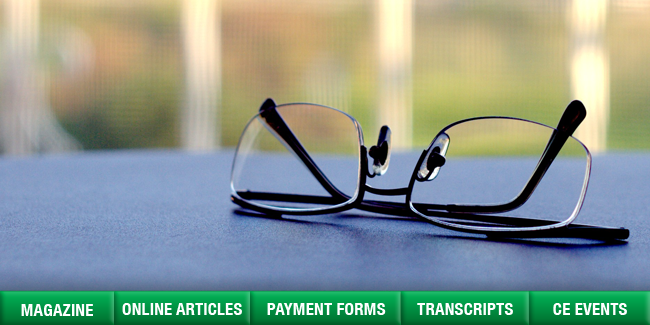A new tool for the optometrist in the treatment of recurrent corneal erosions.

A new tool for the optometrist in the treatment of recurrent corneal erosions.
|
|
Recurrent corneal erosions (RCEs) are not as common as certain other ocular conditions, but can prove to be very challenging to resolve. New forms of treatment have been added to the arsenal of care and should be considered when treating patients who suffer from this condition. RCEs were first described in 1872 by Hansen, (1) and can be divided into two categories: microform and macroform. The macroform variety is defined as a widespread loss of epithelium with severe symptoms. It is easily recognized by an optometrist during a clinical exam. The symptoms may span over multiple days. The recurrence happens over intervals of weeks, months or even years. The microform category is defined as a small area of epithelial loss. The events are milder and shorter than the macroform, but occur as often as every evening or morning.(2)
A RCE can occur spontaneously, or follow a previous superficial corneal injury or occasionally it can be sequelae of certain corneal dystrophies.(3) RCE has a fairly pathognomonic presentation: a patient comes in and complains about severe eye pain upon waking, photophobia, watering, foreign-body sensation and/or discomfort.
Common management options for RCE have historically included: topical lubricants, hyperosmotic agents, topical steroids, corneal debridement, therapeutic bandage contact lenses, and anterior stromal puncture. Recently, an additional option of using an amniotic membrane tissue (AMT) to aid in the healing process has become more readily available and acceptable. There are several types of accessible amniotic membrane, commonly falling into two categories: dehydrated vs. hydrated tissue. For this article, I would like to focus on the most commonly utilized AMT on the market today, specifically the hydrated amniotic tissue PROKERA® SLIM from BioTissue and its use in a case presentation.
A 34-year-old white male presented to our office with complaints of foreign body sensation OS for one year along with redness. He had been seen previously at another ophthalmology practice where he was treated for a previous corneal abrasion from his six-month-old son. He reported that he was given a bandage contact lens for two to three days to no avail, and was currently taking Muro 128 ointment OS at bedtime, Muro 128 drops QD OS and Refresh tears BID OS. The patient was concerned that his old injury had come back and he recalled the symptoms were very similar every two to three months. The patient expressed a desire for a more permanent cure for his recurring symptoms.
Visual acuity without correction was 20/25 OD (improved to 20/20 with pinhole) and 20/40 OS (improved to 20/20 with pinhole). Anterior segment evaluation by slit lamp examination revealed 2+ diffuse injection on the conjunctiva OS with a healing area from what looked to be a recent corneal erosion OS (pinpoint staining with a small epithelial defect). Superficial to the erosion was 1-2+ map-dot-fingerprint (MDF) dystrophy. Surrounding the area of erosion was 2+ diffuse sub-epithelial keratitis.
From the patient’s history, we diagnosed a resolving yet chronic RCE OS along with sub-epithelial keratitis OS most likely associated with the resolving RCE. The patient was educated on the pathophysiology of the chronic RCE due to the initial corneal abrasion and subsequent MDF, and was told to continue using the Muro 128 ointment at bedtime, and the Muro 128 gtts QD OS. The patient was also prescribed off label Durezol gtts TID OS for the sub-epithelial keratitis and to aid in the resolution of the inflammation present at the initial evaluation. The purpose of steroid treatment was to quickly eliminate any underlying inflammation prior to Prokera® AMT insertion. With this initial presentation and the duration of the disease, I intended to debride the cornea at the follow-up and wanted to address the inflammation as directly as possible. The patient was educated on treatment of corneal debridement with associated AMT to help prevent future RCE occurrences. The patient was advised to return to the clinic in seven days for a follow up debridement and AMT placement OS.
At his first follow-up, the patient reported no redness, no photophobia, and no irritation since the last office visit. He reported stable vision and no discomfort. He was compliant with his drop regimen.
Visual acuity had improved to 20/15 OD and 20/15 -2 OS. Slit lamp examination showed marked improvement in the sub-epithelial keratitis OS to trace findings. There were no epithelial defects and 1+ MDF dystrophy. The area of erosion had healed and there was only a trace area of sub-epithelial keratitis.
I proceeded to debride his cornea OS to remove the unstable/fragile epithelium and scrape the basement membrane. I then inserted a PROKERA® SLIM (as seen in sample figures 1-3; please note the sample figures are not of patient being currently presented) and applied medical tape on the upper lid along the lash line to minimize the discomfort from the PROKERA® ring as well as limit movement to aid in epithelial regrowth. The PROKERA® SLIM amniotic tissue is held by a plastic rings (see sample figure 4) and doesn’t require a bandage contact lens to hold the AMT in place. The patient was prescribed Tylenol #3 for pain and was told to discontinue Durezol gtts and Muro ung and gtts OS. He was also prescribed Vigamox TID OS to prevent a secondary infection. The patient was scheduled for a one week follow-up to remove the PROKERA® ring and check the healing of his cornea.
|
Figure 1 |
Figure 2 |
Figure 3 |
|
Figure 4 |
At his next follow-up visit, the patient reported that he was doing well and feeling much better since the last office visit. The patient also reported the PROKERA® ring had dislodged itself when the patient had rubbed his eye three days prior. Uncorrected visual acuities were 20/20 OD, OS. Slit lamp examination revealed some trace sub-epithelial keratitis, no MDF, and no pithelial defects. The eye was otherwise unremarkable. The patient’s condition had improved with no signs of recurrence. The patient was advised to restart Durezol gtts QD OS for one week to address the residual keratitis along with Muro 128 ung QHS OS going forward to prevent future RCE. He was also prescribed oral doxycline 50 mg QD for 30 days. The patient was instructed to return if any of his symptoms recurred. He has since returned for his annual comprehensive eye exams and has not had any RCEs in his OS eye.
Traumatic corneal abrasion, a leading precipitating cause for recurrent corneal erosion, is one of the most common causes for attendance in eye casualty and general emergency departments.(4) Abnormal formation of hemi-desmosomes or anchoring filaments (cellular attachments) at the basal layer of the corneal epithelium are believed to play an important role in the pathogenesis of recurrent corneal erosion.(5) Matrix metalloproteinases (extracellular proteolytic enzymes) may have a role in degrading epithelial cell attachments.(6) A shearing force on the corneal epithelium may then occur due to movement of the lid on waking or of the eye during rapid eye movement sleep thus producing a corneal erosion.(7)
First line of treatment usually starts with an antibiotic ointment followed by a hyperosmotic OTC ointment like Muro 128 at bedtime which has been shown to be effective and successful.(8) The use of bandage contact lens (silicone hydrogel) can minimize the discomfort caused by the erosion and help protect the epithelium from the eyelids.(9) Hyperosmostics produces an osmotic gradient, promotes epithelial adherence, and minimizes overnight epithelial edema. All of these treatments can help to reduce the frequency of RCEs.
For patients suffering from more severe or more frequent cases of RCE, additional therapies can be considered. Corticosteroids inhibit matrix metalloproteinase-9 (MMPs) that cause epithelial breakdown. Doxycycline also inhibits MMPs, and improves meibomian gland production at the same time. Certain studies have indicated continued treatment with corticosteroids and doxycycline regimen for two months to prevent future recurrences.(10) Topical immunomodulators, such as 0.05% cyclosporine-A (Restasis; Allergan, Irvine, CA), reduce the likelihood of RCEs by improving the lacrimal and mucin tear layer quality by inhibiting lacrimal gland T-lymphocyte proliferation and increasing goblet cell numbers, which can help decrease corneal friction. Punctual occlusion can improve the quality of the tears by increasing the aqueous component of the tear film and diminish its osmolarity. Additionally, autologous serum when applied to RCE has all the necessary glucose, proteins and calcium for the epithelium to migrate or heal quicker, but can be difficult for a patient to acquire and costly to maintain treatment long term. Vitamin A and fibronectin found in the serum also speeds up the healing process.
There is a new treatment protocol that a primary care optometrist can employ to treat recurrent corneal erosions in office, involving corneal debridement and amniotic tissue transplantation. Debridement of a loosely adherent corneal epithelium is necessary to promote the healing from the healthy periphery but still results in 18 percent recurrence if used alone.(11) As shown by Itty, et al., in their 2007 article Outcomes of epithelial debridement for anterior basement membrane dystrophy, corneal debridement is a simple technique that is as effective as other procedures used to treat chronic EBMD. In California, it is within the scope of practice to debride the corneal epithelium. However, if debridement is used in concurrence with a cryopreserved amniotic membrane like PROKERA®, the wound healing process speeds up due to the anti-inflammatory, anti-scarring and anti-angiogenesis properties of the tissue and can help promote proper adhesion of the basement membrane to the regrown epithelial cells.(12)
In the case of our patient, despite the short duration of Prokera® AMT being on the eye, studies have indicated that the average time of complete epithelialization following debridement was four to seven days.(13) The desired outcome of addressing his recurrent condition in a manner to ideally prevent future occurrences was achieved as the patient has yet to return to our clinic with symptoms of an RCE since this treatment.
References
1. Hansen E. Om den intermittirende keratitis vesiculosa neu ralgica af traumatisk oprindelse. Hospitals-Tidende 1872;15:201-3.
2. Hope-Ross et al. Recurrent corneal erosion: Clinical features. Eye 1994; 8:373–377.
3. Bron AI et al. Inherited recurrent corneal erosion. Trans Ophthalmol Soc UK 1981; l0I:239–43.
4. Jones NP et al. Function of an ophthalmic 'accident and emergency' department: results of a 6-month study. British Medical Journal 1986; 292(6514):188-90.
5. Wood TO. Recurrent erosion. Transactions of the American Ophthalmological Society 1984; 82:850-98.
6. Dursun D et al. Treatment of recalcitrant recurrent corneal erosions with inhibitors of matrix metalloproteinase-9, doxycycline and corticosteroids. American Journal of Ophthalmology 2001; 132(1):8-13.
7. Watson SL et al. Interventions for recurrent corneal erosions. Cochrane Database Syst Rev. 2012 Sep 12; 9:CD001861.
8. Foulks GN. Treatment of recurrent corneal erosion with topical osmotic colloidal solutions. Ophthalmology 1981; 88:801-3.
9. Fraunfelder FW. Treatment of recurrent corneal erosion by extended-wear bandage contact lens. Cornea 2011 Feb; 30(2):164-6.
10. Wang L et al. Treatment of recurrent corneal erosion syndrome using the combination of oral doxycycline and topical corticosteroid. Clin Experiment Ophthalmol. 2008 Jan-Feb; 36(1):8-12.
11. McGrath LA et al. Corneal epithelial debridement for diagnosis and therapy of ocular surface disease. Clin Exp Optom 2015 Mar; 98(2):155-9.
12. Meller D et al. Amniotic membrane transplantation in the human eye. Dtsch Arztebl Int. 2011 Apr; 108(14):243-8.
13. Huang Y, Sheha H, Tseng SCG (2013) Self-retained Amniotic Membrane for Recurrent Corneal Erosion. J Clin Exp Ophthalmol 4: 272 doi: 10.4172/2155-9570.1000272.
14. Itty S, Hamilton SS, Baratz KH, et al. Outcomes of epithelial debridement for anterior basement membrane dystrophy. Am J
Ophthalmol 2007; 144:217–221
1.png)

1.png)



.png)




.png)
.png)
.png)
.jpg)
.png)





.png)
.png)
.png)
.png)
.png)

.png)

.png)
.png)
